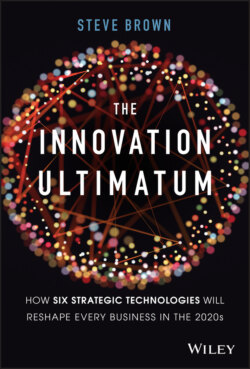Читать книгу The Innovation Ultimatum - Steve Brown - Страница 43
Pattern Recognition
ОглавлениеPattern recognition is a core capability of many AI systems, including the radiology example we just discussed. Pattern recognition has many applications and comes in a range of different flavors. It's not important that you remember all these different approaches. They are listed here only to illustrate some of the fundamental capabilities of machine learning. As you read through them, think about how such a capability might be used to solve business problems in your organization.
Classification. AI can classify data into similar types. For example, the radiology AI classifies images as positive or negative. A similar approach might be used to do visual inspection and quality assurance in a manufacturing plant, or to identify spoiled or underripe fruit at a fruit-packing plant.
Clustering. Marketing professionals use clustering algorithms to partition consumers into market segments that share similar characteristics—buying habits, affluence level, and needs or desires. Recommendation engines use clustering, too. Spotify recommends songs that you might enjoy by analyzing historical listening habits. A clustering algorithm finds the complex relationships between songs and listeners. The clustering algorithm might see that I like songs A, B, C, and D, and that you like songs B, C, D, and E. It may conclude that it's probable you will enjoy song A and I might enjoy song E. Clustering is useful to deliver personalized experiences.
Regression analysis finds patterns that describe relationships between pieces of data. For example, regression analysis might observe that if Event A happens, most of the time Event B follows. More complex relationships are found, too, such as “if Datapoint A is below a certain threshold, and Event B and Event C are not happening, then Event D is 46% more likely to occur.” This approach is used to make predictions about the future with predictive analytics tools. Regression analysis is used by Walmart to predict how sales of certain food items are influenced by specific weather conditions.
Sequence labeling is a pattern-recognition approach used in speech recognition, handwriting recognition, and gesture recognition. Sequence labeling is used to break sentences down into constituent words and phrases and to label them in a way that captures their context. For example, sequence labeling identifies which words are nouns, verbs, and proper names. Words are best interpreted in the broader context of a sentence. Sequence-labeling algorithms classify words within a sentence, or cursive letters within a handwritten word, by examining the broader context surrounding them.
Time-series prediction is used in weather forecasting, stock market prediction, and to predict disasters. These algorithms analyze a set of historical data points and use that to project which data points might come next in a sequence.
These pattern-matching algorithms use complex mathematics to work their voodoo. You don't need to understand how pattern matching works, or even recall the names of all the various techniques listed above. What you do need to understand is that AI makes it easier for computers to understand the physical world, to make predictions, and to find complex relationships hidden inside data. These tasks are at the root of solving many business problems.
